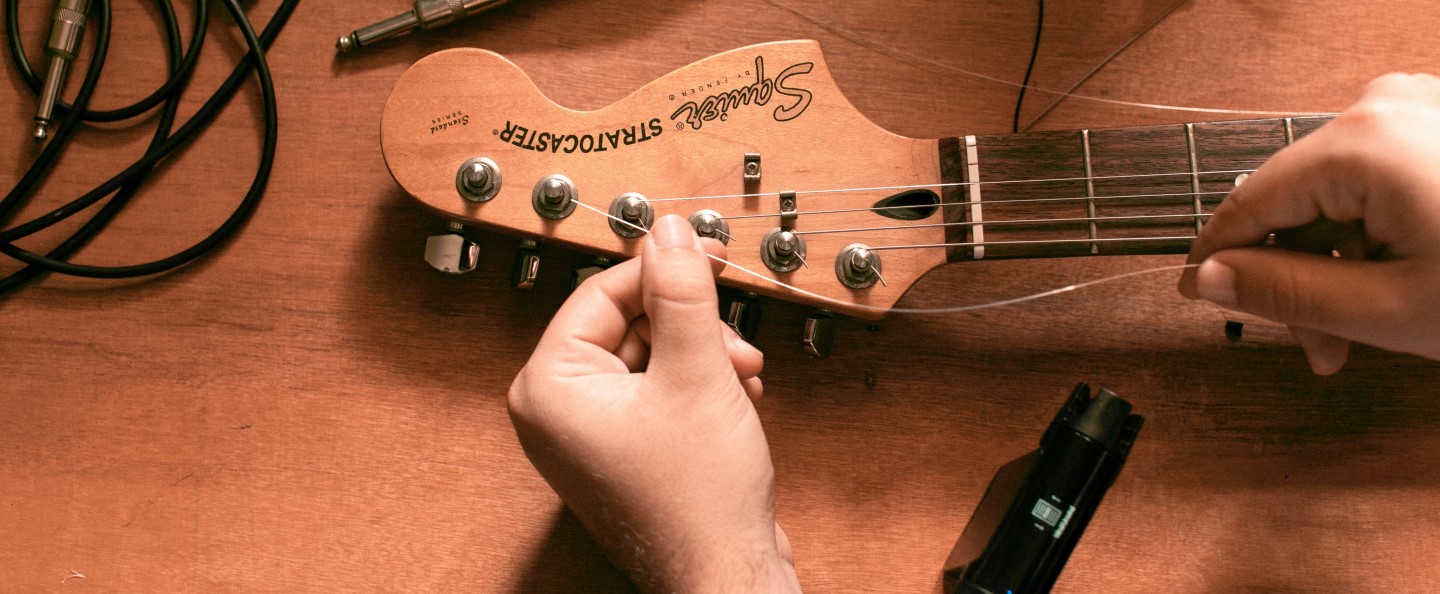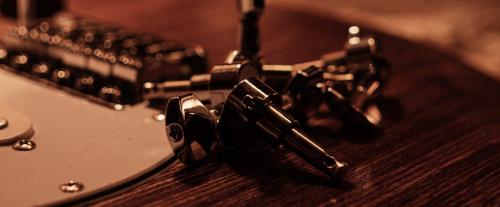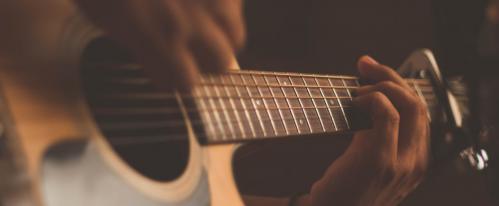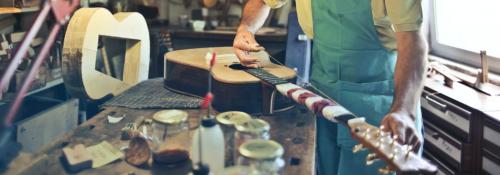Find out about the best alternate tunings for guitar and read up on our favourite tips for downtuning in this blog
In this blog we’ll be exploring the vast world of non-standard tunings for guitar. Whilst taking your first steps beyond the much-loved E-A-D-G-B-E might seem difficult, we’ll be rounding up some of our favourite easy alternate tunings for beginners as well as looking at chord shapes, progressions, and songwriting in our complete alternate tunings guide.
Alternate Guitar Tunings
Learning how to play in alternate tunings might seem difficult at first - but once you’ve learned how to utilise them effectively they will greatly enhance your guitar skills and overall musicianship.
An alternate guitar tuning is any guitar tuning that strays from what is known as ‘Standard Tuning’, or E-A-D-G-B-E.
So why should you use alternate guitar tunings?
Why Use Alternate Guitar Tunings?
There are many reasons why you might choose to use an alternate guitar tuning. Some tunings are particularly suited for different genres - alternate guitar tunings for metal often utilise lower notes on extended range instruments.
On the other hand, blues musicians will often use alternate tunings for slide guitar, and in some indie and folk genres there are alternate tunings for acoustic guitar that take advantage of droning open strings - more on that later!
There are plenty of cool alternate tunings for guitar, and to prove it we’ve picked out some of our favourite guitarists who are known to experiment with (or sometimes exclusively use!) instruments that are set-up in non-standard tunings.
Guitarists That Use Alternate Tunings
Some of the best-known purveyors of alternate guitar tunings are Thurston Moore, Lee Ranaldo, and Kim Gordon of Sonic Youth. They used over 80 different tunings across the band's extensive discography, and are still well-known for their experimental guitar work and utilisation of noise both live and in the studio.
You can find out a bit more about the sort of gear that they used by clicking below:
Another band that likes to delve into this world is Radiohead - hardly surprising given their penchant for experimenting with sound.
Sometimes Thom Yorke and Jonny Greenwood opt for fairly straightforward tunings, such as using Drop D (D-A-D-G-B-E) on Bodysnatchers and 2+2=5. Other times the tunings are a little less common, with Thom opting for D-G-B-G-B-D on Permanent Daylight and C-G-C-F-A-D on The Numbers.
Some further guitarists who are known to use alternate tunings include: Keith Richards, Joni Mitchell, Curtis Mayfield, Stephen Malkmus, Nick Drake, and John Cale.
Do I Need Different Guitar Strings For Alternate Tunings?
If you plan on getting started with alternate tunings, you might want to invest in some extra guitar strings first.
Some alternate tunings are better suited to heavier gauge strings in order to keep the tension across your guitar neck suitable, and some people who are lucky enough to own more than one guitar will often opt to set-up each instrument in a different tuning so they don’t constantly have to re-tune or adjust their guitar neck.
Are Alternate Tunings Bad For Your Guitar?
So now you might be wondering: “Is it bad to change tunings on your guitar?” or “Does alternate tuning hurt the guitar?”
Whilst we wouldn’t recommend changing between Drop C and Open F# too often, as long as you keep your guitar in good health and regularly set it up you shouldn’t encounter any long-term issues with your instrument.
Be extra careful when using alternate acoustic tunings, though - some acoustic instruments may be more difficult to re-set, and altering the truss rod can be more complicated than on electric guitars.
What Is Downtuning?
Downtuning refers to any alternate tunings that use lower notes than that which would be used in standard. This can refer to just lowering the note on one string - for example, in Drop D - or across other strings, too.
Downtuning a guitar is useful for those playing around with heavier tones, and so it’s often used by metal musicians. Although any guitar can be downtuned, the best guitars for downtuning will usually have certain features which make it easier to play and sound great across an extended frequency range.
These guitars have specific pickups for downtuning - often ‘Active’ variants - which can capture lower frequencies without sounding ‘muddy’ or lost within a mix. They often have a non-standard scale length too, and will probably come factory-equipped with the best guitar strings for downtuning.
If you need to get really heavy, you can check out our range of 7 and 8-string guitars below:
Are Baritone Guitars Worth It?
If you’re not too keen on using more than 6-strings but still want to droptune beyond the range of your current guitar, you could invest in a baritone guitar. These guitars have longer scale lengths and are set up in standard from B to B - a perfect 4th lower than a standard guitar.
This means that instead of being tuned to E-A-D-G-B-E, they are set-up in B-E-A-D-F#-B. Downtuning on a baritone instrument can lead to some really gnarly tones!
As mentioned earlier though, there are no rules when it comes to downtuning - so let’s look at some different types..
How To Down Tune A Guitar To Drop D?
Drop D is a very popular alternate tuning. This is because it is extremely easy to set-up a guitar in this tuning, and it’s also quite easy to make songs and riffs sound good, too!
To tune down to Drop D from standard, simply lower your low E string by two semitones to D. This will put your guitar in D-A-D-G-B-E, which offers many benefits for certain sorts of playing.
Most noticeably, it means that power chords can be played with one finger due to the octave now being on the same fret between the two matching D strings. This helps with utilising open strings, hammer-ons and pull-offs.
Try writing a riff in Drop D by moving between the open D power chord and adding some flourishes in other places on the neck as you strum.
What Does Half-Step Down Tuning Mean?
Playing a ‘Half-Step Down’ is when each string on your guitar is tuned to one semitone below what it would normally be. This means your guitar would be setup in Eb-Ab-Db-Gb-Bb-Eb (or D#-G#-C#-F#-A#-D#).
Some guitarists use this tuning simply to relieve tension on the strings and make bends a little easier - others find that it matches their singing voice a little better, and so use it to compensate for that. It can be beneficial when playing with other instruments such as horns too, depending on the arrangement.
This tuning uses the same intervals as standard, and so in that sense it’s not exactly an alternate tuning - you’ll probably notice that lots of artists use it though, so it’s worth being aware of!
Jimi Hendrix was a big fan of using Eb tuning, so try it out and see if it makes bending and vibrato a little easier.

Open Guitar Tunings
Many people get confused when learning how to use open tunings, but they’re actually very simple to figure out if you spend a little time with them.
An ‘Open Tuning’ is any tuning in which playing a completely open chord - that is, with no frets being pressed down - results in a perfect chord. So for example, when a guitar is strummed in Open D, the resulting sound is a perfect D chord.
Open D is achieved when a guitar is set-up in D-A-D-F#-A-D - all of the notes which form a D chord!
Many guitarists employ open tunings as a way to discover brand-new voicings, but they also allow for extra flexibility in terms of riffing on certain scales that sit well on top of the open chord - by leaving certain strings to drone, it’s possible to play lead and rhythm sections at the same time more easily.
This can give a really unique effect and can make what you’re playing sound much more complex than it actually is.
Folk music uses a lot of these types of tunings, but they’re also popular in math rock, midwest emo, and other sub-genres of indie and alternative rock.

Using a Capo
Using a capo is perhaps the most simple way to alter the tuning of your guitar. Whether you are playing in standard or in an alternate tuning, placing a capo on the neck will alter the pitch of your open strings and allow you to perform the same chord shapes in a different register.
Whilst a capo does not change the intervals between the strings - similarly to how tuning to a half-step down is still, technically, a form of standard tuning - having a capo in your arsenal will allow you to pitch up your chord progressions to suit your voice or other instruments.
This makes them an incredibly useful tool for songwriters and composers who may need to transpose their work at a moment's notice, or for those who want to experiment with how chords sound in different positions across the neck.
For a full range of capos available, click below:
That just about wraps up our guide to playing guitar in some non-standard tunings - keep experimenting with different ways of playing, and try to learn some chords and songs in other tunings too!
Need some extra help with 7-string alternate tunings? Struggling to figure out how to tune without breaking strings? Call us on 0151 448 2089 or check out your local store to speak to one of our Experts about your needs.




